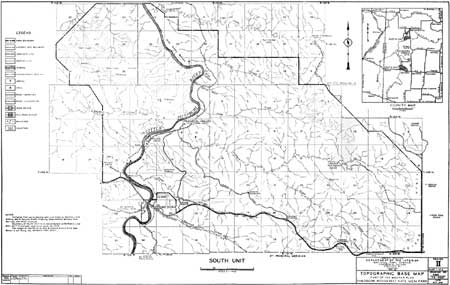
|
North Dakota History
Geology of the South Unit, Theodore Roosevelt National Memorial Park |
ROAD LOG THROUGH THE PARK
| Going West Read Up | Going East Read Down | |
| 0.0 | 10.9 | Leave main highway on west end of Park area. |
| 0.5 | 10.4 | Old entrance to Park |
| 0.8 | 10.1 | Sandstone concretions. Note holes made by wind abrasion. Bank swallows nest in these holes. |
| 1.5 | 9.4 | Sandstone concretions on west side of road. Clinker caps hills to the northeast. |
| 1.6 | 9.3 | Sandstone concretions. Close inspection shows excellent ripple mark cross bedding. |
| 1.8 | 9.1 | Edge of Johnson Plateau. Edge of the upper old valley which is the No. 4 level of this report. |
| 2.5 | 8.4 | Note clinker capping hills to the northeast. |
| 2.9 | 8.0 | Begin dropping off the Johnson Plateau. |
| 3.7 | 7.2 | Begin the No. 3 terrace level. |
| 3.9 | 7.0 | Edge of the No. 3 terrace level. Start the No. 2 terrace. |
| 3.95 | 6.95 | Road to the south to the picnic area. |
| 4.1 | 6.8 | Road to the east, junction with road to Park Headquarters. |
| 4.2 | 6.7 | Inner edge of the No. 2 level. |
| 4.5 | 6.4 | Inner edge of the No. 3 level. |
| 4.6 | 6.3 | Impure lignite outcrop. |
| 5.0 | 5.9 | Lignitic shale in the road ditch. Badly broken plant fossils. |
| 5.1 | 5.8 | View to west over Little Missouri Valley. |
| 5.2 | 5.7 | White efflorescense on the rocks is probably calcium carbonate brought to the surface and deposited when the water evaporated. |
| 5.4 | 5.5 | Note clinker capping the hills to the north. Poor grade of lignite in road ditch on south side of road. |
| 5.8 | 5.1 | Massive sandstone concretions on the south side of road. |
| 6.4 | 4.5 | Good stand of badland cedar. Note clinker on hilltop to south. |
| 6.5 | 4.4 | Sandstone concretions to the south. |
| 6.7 | 4.2 | Clinker outcrop showing some of the unburned coal still present with ash at the top. |
| 6.9 | 4.0 | Note level to the north. This level is probably equivalent to the level of the Johnson Plateau and is probably part of the old upper stream surface (No. 4 Level). Note clinker to the north above the road. |
| 7.0 | 3.9 | Clinker outcrop to north. Note the excellent example of pseudocolumnar jointing. |
| 7.1 | 3.8 | Note sandstone concretions and how they cap erosion pillar to the south. |
| 7.2 | 3.7 | Note extensive gullying on the sides of the buttes to the north. Clinker to the north and south. |
| 8.2 | 2.7 | Road to south to Ridgeline Nature Trail Good stand of badland cedar. |
| 8.3 | 2.6 | Log-like sandstone concretions at road side to the north. Thin zone of these concretions runs to the east here for a short distance. |
| 8.6 | 2.3 | Excellent view to south. Highest level seen is probably the same as the Johnson Plateau (No. 4 level). The level below it is probably the No. 3 level. Fine examples here of gullying on the sides of the buttes. Note also the bedding of the bedrock strata. |
| 8.7 | 2.2 | Note dark gray and purple lignitic shales to the north. |
| 8.75 | 2.15 | Parking overlook. In the general view to the north and west the level immediately below upland surface is probably the No. 4 level. Note clinker below the overlook and in the distance. |
| 9.0 | 1.9 | Note the small bench held up by gray clay. Note Sequoia stumps to the north. |
| 9.3 | 1.5 | Note sandstone concretions to the north. |
| 9.5 | 1.4 | Good examples of gullying on both sides of road. |
| 9.6 | 1.3 | Small cave to the north on the side of a butte. |
| 9.9 | 1.0 | Fossil Sequoia stump zone on the north side of the road. |
| 10.3 | 0.6 | Clay-capped buttes on both sides of the road. |
| 10.4 | 0.5 | Good examples of gullying action. |
| 10.9 | 0.0 | Checking station at the east end of the Park. |

|
| Plate 1. Map of the Park area. (click on image for an enlargement in a new window) |
| <<< Previous | <<< Contents >>> |
state/nd/1950-17-4/sec2.htm
Last Updated: 28-Mar-2006